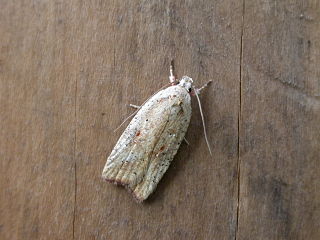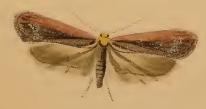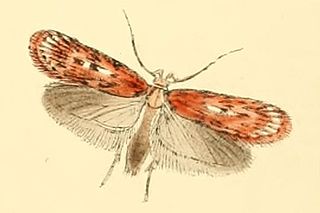
The gorse tip moth is a smallish moth species of the family Depressariidae.

Depressaria is a genus of moths in the superfamily Gelechioidea. It is the type genus of subfamily Depressariinae, which is often – particularly in older treatments – considered a distinct family Depressariidae or included in the Elachistidae, but actually seems to belong in the Oecophoridae.

Blunt’s flat-body or purple carrot-seed moth is a moth of the family Depressariidae. It is found in most of Europe. It is also found in the Near East, North Africa, the eastern part of the Palearctic realm and since 2009 in North America. In the former USSR, it is distributed in the entire European part except for the Far North. It is also found in the northern Caucasus and Transcaucasia, in Kazakhstan, Central Asia, the south of Siberia, and the Russian Far East. It is an introduced species in North America, where it has been reported from Québec and Ontario.

Depressaria albipunctella is a moth of the family Depressariidae. It is found in most of Europe, as well as in Libya.

Depressaria chaerophylli is a moth of the family Depressariidae.

Depressaria libanotidella is a moth of the family Depressariidae. It is found in most of Europe, except Great Britain, Ireland, the Benelux, Portugal, Norway, Poland, most of the Balkan Peninsula and most of the Baltic region.

Depressaria silesiaca is a moth of the family Depressariidae. It is found in Great Britain, Fennoscandia, Estonia, Latvia, Russia, Poland, the Czech Republic, Austria, Switzerland and Italy.

Depressaria artemisiae is a moth of the family Depressariidae. It is found in most of Europe, except Ireland, Great Britain, the Netherlands, Belgium, the Iberian Peninsula and most of the Balkan Peninsula. It is also found in North America.
Depressaria daucivorella, the anise moth, is a moth of the family Depressariidae. It is found in France, Switzerland, Austria, Italy and on Cyprus. It has also been recorded from Israel, Turkey and Iraq.
Depressaria douglasella is a moth of the family Depressariidae. It is found in most of Europe.
Depressaria marcella is a moth of the family Depressariidae. It is found in France, Spain, Portugal, Slovakia, Hungary, Croatia, Romania, Bulgaria, North Macedonia, Greece and Turkey and on Sardinia and Sicily. It has also been recorded from Israel, Iran and North Africa.

Depressaria pulcherrimella is a moth of the family Depressariidae. It is found in most of Europe, except the Balkan Peninsula.

Depressaria sordidatella is a moth of the family Depressariidae. It is found in most of Europe, except Ireland, Portugal, Belgium, Ukraine and most of the Balkan Peninsula.

The parsnip moth or parsnip webworm is a moth of the family Depressariidae. It is found in most of Europe, except Portugal and most of the Balkan Peninsula. This species has also been introduced into New Zealand.
Depressaria besma is a moth in the family Depressariidae. It was described by Clarke in 1947. It is found in North America, where it has been recorded from Washington and California.
Depressaria betina is a moth in the family Depressariidae. It was described by John Frederick Gates Clarke in 1947. It is found in North America, where it has been recorded from California to Washington.
Depressaria eleanorae is a moth in the family Depressariidae. It was described by John Frederick Gates Clarke in 1941. It is found in North America, where it has been recorded from Alberta, Ontario and in Maine.
Depressaria leptotaeniae is a moth in the family Depressariidae. It was described by John Frederick Gates Clarke in 1933. It is found in North America, where it has been recorded from Oregon, Alberta, Idaho and Washington.
Depressaria multifidae is a moth in the family Depressariidae. It was described by John Frederick Gates Clarke in 1933. It is found in North America, where it has been recorded from Oregon, Washington, Idaho and California.
Barea asbolaea, also known as the chequered bar and the Buryas Bridge moth, is a moth of the family Oecophoridae found in Australia. It was described by the English amateur entomologist Edward Meyrick in 1883. It is an adventive in Cornwall, where it has been recorded since 2004 at three sites.






